Strategic cruise missile X-20: winged "Kangaroo"
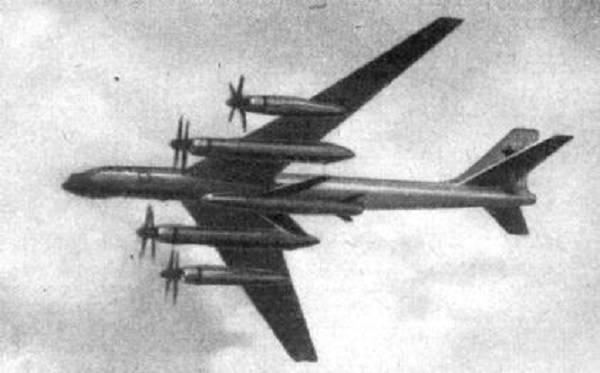
The Kometa-20 aircraft and missile system: the Tu-95K missile carrier and the X-20М cruise missile. Photo from http://militaryrussia.ru
By the beginning of the 1950s, it became quite obvious that the reliance on traditional means of delivering “special ammunition,” that is, atomic bombs, ceases to justify itself. On the one hand, the experience of the war that had just passed led to the explosive growth of air defense systems, which were increasingly difficult for strategic bombers to overcome. On the other hand, the rapid development of rocketry promised to bring ballistic intercontinental missiles to the first roles soon.
In such a situation, when the previous delivery means were already outdated, and the new ones had not yet been created, we had to look for intermediate solutions. But as is often the case, what was intended as a temporary solution was not just permanent, but gave rise to a new species. weapons. Thus arose cruise missiles, first air and then sea and land-based.
However, air-to-ground missiles were initially confronted with former strategic tasks: delivering special ammunition to where the strategic bomber could not reach. To do this, it was necessary to bring their speed to supersonic, and the range to strategic, and at the same time make sure that the carrier aircraft did not even enter the zone of action of enemy air defense.
It was these tasks that were formulated by the resolution of the USSR Council of Ministers on 11 in March 1954, which determined the beginning of the development of the K-20 strategic air-launched missile system, that is, Kometa-20. The carrier was supposed to be a new, just-launched at the stage of serial production of a turboprop strategic bomber Tu-95. Under him, and should create the first in the Soviet Union strategic cruise missile X-20. The “X” index meant an air-based cruise missile. The former definitions of “winged projectile” and “winged projectile-rocket” did not take root, and cruise missiles began to receive their own indices, indicating not class, but class: “X” - air-based, “P” - sea. And the number “20” indicated that the new rocket would be the heiress of the former “Comet” - KS-1, but qualitatively new.
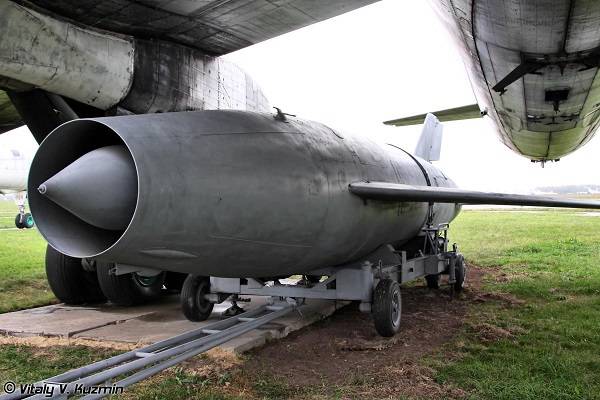
X-20M cruise missile at the Far Museum aviation in Ryazan. Photo from the site http://rbase.new-factoria.ru
The March decree of the Soviet government also determined the enterprises that were to engage in the creation of a new system. They chose those who were engaged in the development of K-1, because they already had experience in the field of creating a new type of weapon. The aviators were in charge of the “aircraft” and “rocket” part: aircraft designer Andrei Tupolev's OKB-156 led the revision of the Tu-95, Artyom Mikoyan and Mikhail Gurevich was taking over the creation of the new rocket (it was Gurevich who became the curator of the missile theme and the chief designer on the subject). The control system in the structure of the new complex was occupied by KB-155 under the leadership of Vitaly Shabanov - the future of the NPO Almaz. And for a special ammunition, that is, a nuclear warhead, he was responsible for KB-1 in the closed city of Arzamas-11 - the current VNIIEF in Sarov.
Rocket like a fighter
As with its first cruise missile, the KS-1, with the new X-20, the designers, under the command of Mikhail Gurevich, did not elaborately slyly. If, in the appearance of the OKB-155 rocket firstborn, the MiG-15 fighter was easily guessed, then the appearance of the G20 showed its origin from the MiG-17 and its ilk. What was clear: a new cruise missile should be made supersonic, so that it was inaccessible to most of its modern fighter jets.
In general terms, the ruling from 11 March 1954, the year has formulated the requirements for a new cruise missile. The speed is not lower than 1700-2000 km / h, that is, of the order of 1,5-2 M. The flight range is not less than 600 km, so that there is a possibility of defeating large strategic targets outside the enemy's air defense. Rocket altitude - 12-13 kilometers, which also hampered the actions of air defense. To be equipped with a new cruise missile, which became the first Soviet supersonic strategic cruise missile, was supposed to have a special combat unit, that is, nuclear weapons, the weight of which, with all associated systems, reached 4 tons with a power of at least 400 kilotons.
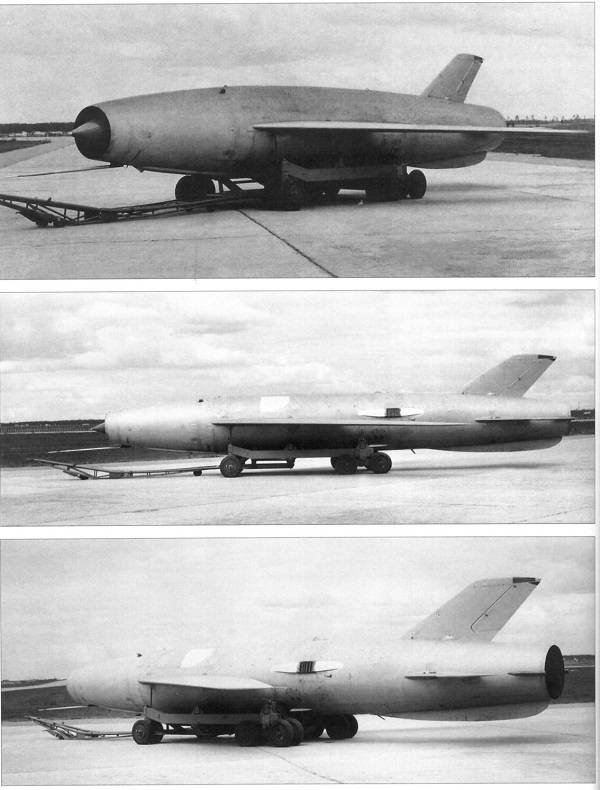
One of the first prototypes of the X-20 cruise missile. Photo from http://www.russianarms.ru
It was these conditions that determined both the appearance and the dimensions of the X-20. Outwardly, it looked like a MiG-17 fighter and a promising interceptor of the same design bomber, the I-7U. From the first rocket they got a characteristic keel and swept wings, from the second - a characteristic air intake with a cone-shaped central body. If it were a little later, one could say that the nose of the X-20 is very similar to the cockpit of the MiG-21F, but its development began a little later, and he clearly inherited the solutions used in the design of the X-NUMXУ.
But being externally similar to the MiG-17 and MiG-19, the strategic X-20 cruise missile was significantly longer: 15,4 and versus 11 in the “seventeenth” and 13 - in the “nineteenth”. In this case, the wingspan of all three aircraft was almost the same: 9-9,3 meter. However, in the case of the X-20, this meant that the designers could afford to make the wing smaller than an airplane with the same fuselage length. This decision was explained simply: a cruise missile was not required to be able to fly at low landing speeds or perform maneuvers, dodging enemy fighters. For the same reason, it was possible to abandon the flaps and brake flaps, placing ailerons on the "flap" places - and thus avoiding the danger of their reverse, which on supersonic airplanes led to an opposite roll reaction.
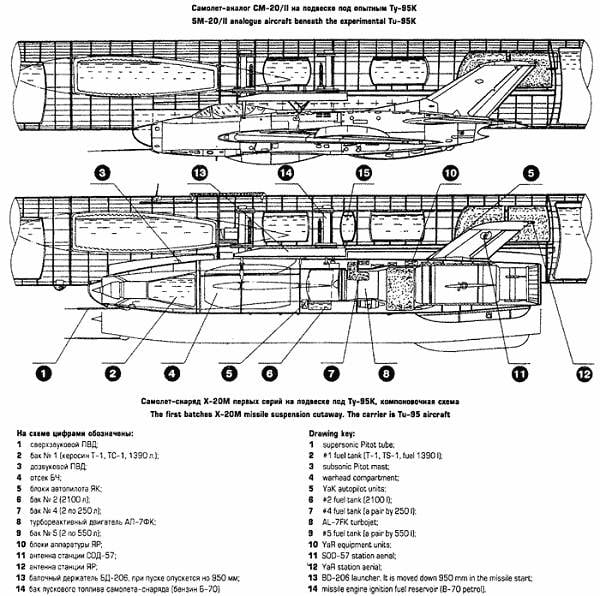
The layout of the aircraft analogue and cruise missile X-20 in the cargo compartment of the Tu-95K. Photo from http://www.airwar.ru
Smaller were the size and tail. According to the practice adopted in aircraft building, usually its area is 20-25 percent of the wing area. And the X-20, the figure was only 16% for horizontal tail, and only 11,2 - for the keel. This, too, was predetermined by the fact that the cruise missile had nothing to do with the maneuverability of a real fighter. By the way, another characteristic external feature of the G-20 was the unusually shifted forward, to the center of gravity of the rocket, the vertical tail. But this was no longer due to considerations of maneuverability or speed, but only because where the keel of the MiG-17 was freely placed in the cargo compartment of the Tu-95, the keel of the X-20, stay as far from the center of gravity as the fighter, would touch the fuel tanks of the carrier (see the layout of the aircraft-analogue and cruise missile in the cargo hold).
How to command autopilot
While developing a cruise missile that was unusual for its tasks, its creators from the Mikoyan OKB-155 and Shabanovsky KB-1 faced several significant problems. The first of these was that the new AF-7L engine, powerful and high-powered, required exactly the nose air intake - and the aerodynamic silhouette of the rocket required the same. And the layout of the internal space significantly suffered from this, since the need to install air ducts from the air intake to the engine “devoured” the space in which the warhead or guidance equipment could be accommodated. And in principle, with this arrangement of the engine and air intake layout turned out too complicated. However, it was impossible to replace the engine with another - simply there was no other that would provide the rocket with the same speed, and this was one of the most important parameters of the technical specification.
As for the problems with control systems, then everything was determined by the need to create a rocket that would act outside the radio horizon. On the one hand, according to the military plan, after the launch of the cruise missile, the aircraft was supposed to turn around and move at full speed from the launch site - so to speak, to act according to the principle of “fired and forgotten”. But on the other hand, it was difficult to rely on the homing system, because, firstly, equipment of this kind in our country was still of low quality, and secondly, the radar homing heads were not suitable, because the targets that the X-20 were directed to did not differed significant radio imaging. After all, according to the idea that was laid in this cruise missile, it was supposed to replace strategic bombers, that is, to act on the industrial and administrative centers of the enemy, as well as on his communications and facilities related to the manufacture and use of nuclear weapons. And they were not only barely noticeable for active, and even more so for passive radio guidance devices, they were also well disguised and had a strong system of radio interference.
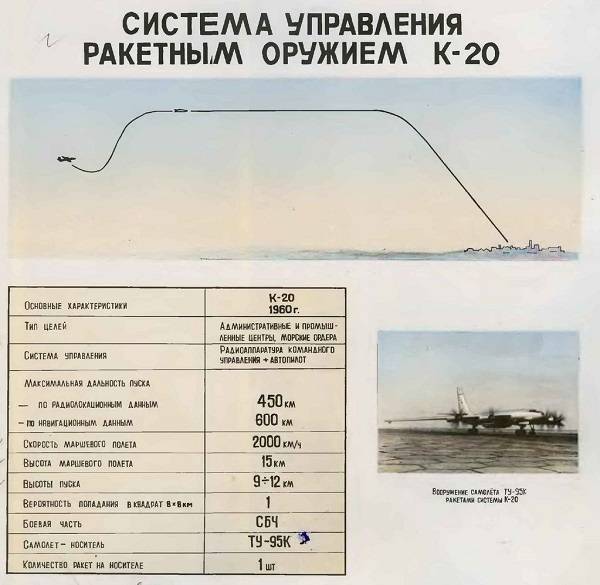
Photo from http://www.russianarms.ru
It was possible to get out of the situation by combining the two guidance systems of the cruise missile. Up to a certain range, it was induced by the carrier with the help of the already developed radio command system, and then the programmable autopilot X-20 entered into action. After all, the same strategic goals that the rocket was aimed at, although they had low visibility, were large, and most importantly, they were fixed! And this means that they could be considered as targets with predetermined coordinates, which should be set to intelligence. And the operators of the aircraft carrier had only to program the cruise missile autopilot appropriately and carry it to the launch site, then send it in the right direction.
Then everything was simple enough. The launch of X-20 was planned to be performed at an altitude of 9-12 kilometers. After that, the cruise missile rose to its march height - 15 km - and accelerated to a maximum speed of 2200 km / h. As soon as the rocket hit the target, the radio navigation equipment was switched off from the carrier, and then the G-20 led to its own autopilot. And only for a short time to connect to the guidance system, adjusting the course of the cruise missile: the autopilot did not take into account the demolition of the projectile, and therefore it was necessary to control it and, if necessary, send it to the target - and disconnect again. This happened when the rocket was not farther than 50 km from the target, and its carrier was within 270-300 kilometers.
If it was about launching the X-20 on a mobile target within the radio horizon - for example, sea warrants (carrier strike groups were from the very beginning one of the main goals for K-20; however, to defeat them, the accuracy of the complex remained low) This was the guidance system of the “remaining range” method. The missile’s deviation from the target — regardless of whether it was due to the accumulated demolition, moving the target itself, or immediately for two of these reasons — was compensated by the commands from the aircraft carrier. Moreover, the communication was two-channel: the wavelength of the radio signal coming from the rocket and to it differed to avoid mutual interference. As soon as the rocket returned to the desired course and the probability of hitting the target was high enough, the command stage ended, and then the X-20 again followed autopilot.
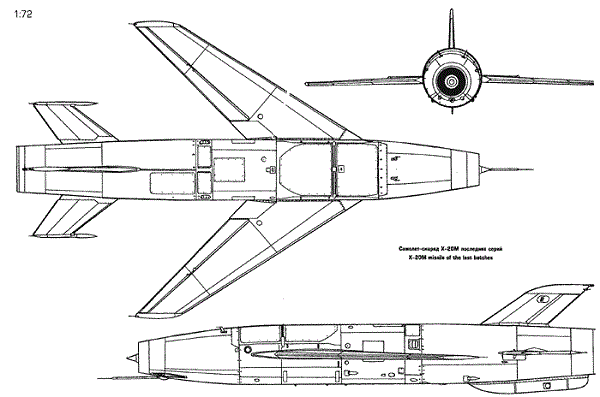
The main projections of the X-20M cruise missile. Photo from http://www.airwar.ru
Despite the external awkwardness and complexity of such a guidance system, at the end of 1950's, it was one of the most effective and reliable — at least for firing at fixed targets, which are essential for strategic weapons. As acknowledged by the American side, before the advent of fourth-generation fighters capable of pursuing and intercepting supersonic targets, as well as prior to the creation of anti-aircraft defense systems that could fight the same targets, the X-20 was almost invulnerable. And if you consider that - at least theoretically! - such a rocket was able to fall guaranteed in a fixed square with a side of 8 km, there was practically no protection against it before the start of the 1970-s.
Tu-95: from bombers to missile carriers
But to create the rocket itself was not enough - it was also necessary to provide it with a means of delivery to the launch site. After all, according to the original specification, the development of the Kometa-20 complex included the creation of an aircraft carrier. Initially, this role was considered already existing strategic bomber Tu-95MA, equipped as a carrier of nuclear ammunition. The preliminary design of the converted bomber at Tupolev Design Bureau was completed by the autumn of 1954, and in the spring of the next at the Samara plant that was producing various modifications of the Tu-95, the first two bombers were designed by Kometa-20.
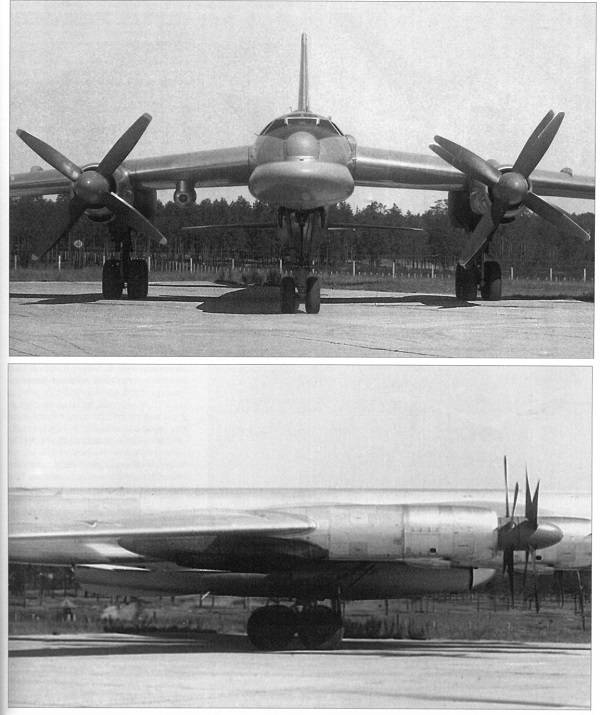
The X-20 cruise missile under the fuselage of the Tu-95K during the tests. Photo from http://www.russianarms.ru
The changes were significant. First of all, to accommodate a fifteen-meter cruise missile under the belly of the ninety-five (the wings were not allowed to completely remove it into the cargo hold), it had to be doubled in length, for which part of the fuselage fuel tanks had to be dismantled and re-assembled. Due to this, the Tu-95K's flight range has noticeably decreased - but it was decided to deal with this a bit later. In addition, a two-antenna radar station, which was part of the cruise missile radio guidance system, was placed in the forward part of the aircraft, mounted a radiometer for controlling the poison, moved the navigator's workplace to the cockpit and removed the bomber and a part of the navigation equipment. But most importantly, it was necessary to develop and install a system in the fuselage to start the rocket engine, warm it up and put it into operation: during a long flight at high altitude, the X-20 propulsion system overheated, and it was very difficult to start it “on cold”.
In addition to all this equipment, it was also necessary to install a DB-206 girder holder in the cargo compartment, which was the main suspension point of the cruise missile, and two grippers that supported it during transport to the launch site. At the same time, in order to ensure sufficient aerodynamic streamlining of the machine with such an "appendage" under the fuselage, it was necessary to invent a semicircular fairing for the X-20 air intake. As a result, the rocket launching process looked like this: when approaching the launching point, the fairing turned and retracted into the Tu-95K fuselage, the holder sank almost a meter down, additional grips diverged, the rocket engine was launched due to the launch system in the cargo hold, and only after that Twenty ”began the path to its goal. And in order to reduce the resistance of the aircraft carrier after the missile was shot off, the cargo compartment was closed with flaps, and Tu began his return journey to the base.
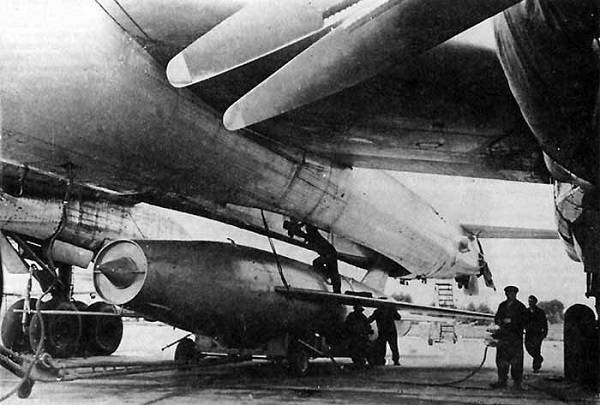
Preparation of the X-20M cruise missile for the suspension to the Tu-95K carrier aircraft. Photo from http://testpilot.ru
There were other, less noticeable changes, the implementation of which took a lot of time. As a result, the first experienced Tu-95K was tested only on January 1 1956 of the year, and the second - in the summer of that year. And in the fall, an analog aircraft, reworked from the MiG-19 fighter, was launched for the first time from one of them. One of the most famous Soviet pilots, twice Hero of the Soviet Union Ahmet-Khan Sultan (the only one of the representatives of the Crimean Tatar people who was awarded the highest award, and twice) sat at his helm.
K-20 coming to the test
A total of two analog aircraft - CM-20 / I and CM-20 / II - performed 150 test flights on the K-20 program, including in the 1957 year - 27 flights independent, taking off from the ground, and 32 flying discharged from an aircraft carrier. The second pair of converted "MiGs", carrying the SM-K / 1 and SM-K / 2 indices, started only from the ground and were used to work out the guidance system, independently entering the beam of the Poison Station. And 17 March 1958 of the year began with the launch aircraft of the first full-scale cruise missiles X-20.
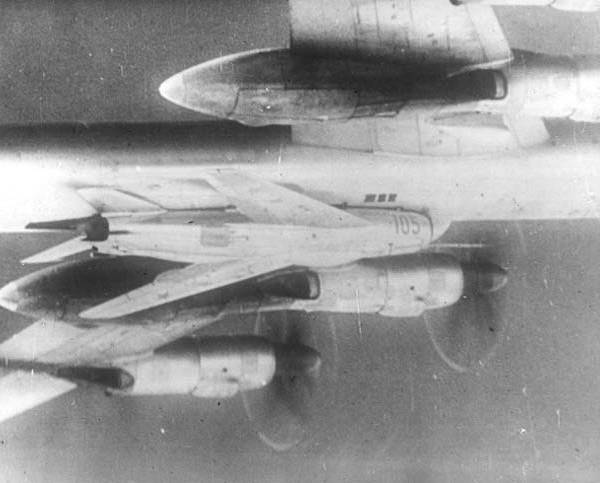
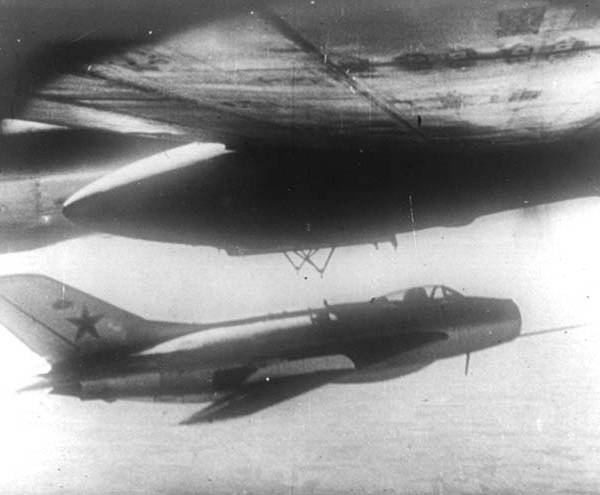
The analogue aircraft CM-20 on the test: at the time of exit to the place of discharge and at the time of discharge from the Tu-95K. Photos from http: //aviaru.rf
It must be admitted that at first the tests did not go too smoothly. So, the first March launch was altogether unsuccessful: the rocket failed to reach a predetermined trajectory due to the failure of two instruments, and in the end could not withstand either the specified range or the specified height, or ensure the accuracy promised by the developers. But this failure did not embarrass anyone: such failures and flaws are characteristic of the initial stage of testing virtually any weapon, not to mention such a complex one as an air-based strategic cruise missile. The month went on completion, and the next launch took place in April, then two more in July, and in the fall it was decided to hand over the K-20 complex for state tests.
By this time, it became finally clear that the carrier in the new system could only be the Tu-95, although initially considered the option of duplex with the participation of the strategic bomber 3М developed by Myasishchev Design Bureau. Both aircraft were quite similar in appearance and characteristics, although they differed in their propulsion systems: the Tupolev machine used four turboprop engines, and the myaschevskaya engine used turbojet engines.
But it was not possible to adapt the X-20 cruise missile under the belly of the 3M. First, the bicycle chassis of the Myasishchev aircraft prevented, and secondly, the insufficient height of the opening. To cope with this, the most amazing tricks were offered: rocket suspension using a special pit, installing it at the top of the fuselage using a crane, fastening under the cabin (that is, in the place where the distance to the ground was greatest) upside down, keel down ... As a result As a working option, the X-20 suspension was offered under one wing, while a large outboard fuel tank was attached for balance under the second. But this decision was too tricky compared to the Tupolev option, and the use of 3M in the K-20 system was finally abandoned.
Finish and redo
October 15 1958 of the year began a joint state tests of the K-20 system - the carrier plane Tu-95K and the strategic cruise missile X-20. They stretched out for a year and ended only on 1 on November 1959. During this time, 16 launches were completed, of which eleven were recognized as credits - despite the fact that the accuracy was not what was required. However, by this time it was already clear that the system of this type would not be accepted for armament, since even before the start of the test, several decrees appeared requiring its completion.
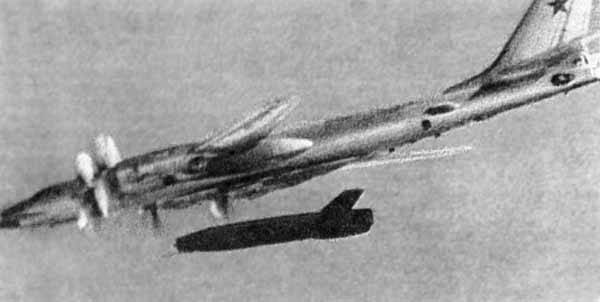
Cruise missile X-20 during discharge from the missile carrier Tu-95K. Photo from http://testpilot.ru
In particular, as early as July 1958, a resolution of the Council of Ministers appeared, demanding an increase in the characteristics of both the aircraft carrier and the entire complex as a whole. The fact is that after the alteration for the X-20 installation, as we recall, the plane lost almost 2000 kilometers in range. And this meant that such carriers could only defeat the targets set aside for the K-20 system at the limit and only acting from airfields in the Far North and the Far East.
At the same time, the cruise missile itself also required rework. Here it was the appearance of a new, more reliable storage and use of a nuclear warhead. The old one, which wore little to no one and that the one speaking the name “6 product” was hydrogen and had a “layered” structure, which imposed certain restrictions on its use. Tests of the new special warhead were going on throughout the 1957 year, and by the time the state tests of the complex began, the replacement was ready.
So in the end, during the tests, the entire reserve of the X-20 cruise missiles was used, after which new ones adapted for the new warhead were used - they received the X-20М index. It is with these missiles that the Kometa-20 complex was adopted on 9 September 1960.
But the transformation of the system, more precisely, its aviation element (from the beginning of 1960's, such systems began to be called aviation-rocket) did not end there. Since 20 May 1960, work has been launched to ensure the necessary range of the Tu-95K, which led to equipping the aircraft with an in-flight refueling system. Such a missile carrier received an index Tu-95KD, that is, distant, and after the completion of its tests 30 January 1962, exactly this option went into production. In total, with the 1958 of the year, that is, from the start of serial production, the Samara aircraft plant launched 28 missile carriers Tu-95KD and 47 missile carriers Tu-95К (some of them were later equipped with the same model CD).
Thirty years in the ranks
As soon as they learned about the new system in the West, it was immediately assigned its own code name - AS-3 Kangaroo, that is, “Kangaroo”. It is clear that in the index system for Soviet cruise missiles, all names began with the letter “K”, but in this case the hit was 100%. The Tu-95 with the X-20 suspended from it was very much like a kangaroo with a cub ...
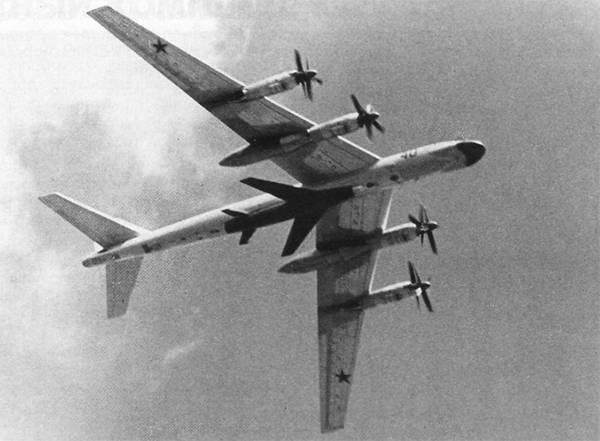
Combat carrier Tu-95K with standard armament - cruise missile X-20M
The first missile Tu-95K entered service in August 1959 year: they were equipped with 1006 heavy bomber air regiment in Uzin near Kiev. The next K-20 complex received the 1226 heavy bomber air regiment in Semipalatinsk, and the last - the 182 th guards heavy bomber air regiment in Mozdok. Since, without a refueling system, the aircraft reached their targets only at the limit of their range, their crews regularly practiced actions from advanced airfields located in the Far North, the Far East and even on ice platforms in the Arctic.
Gradually, as the air defense systems of the likely enemy developed, the advent of 4 generation fighters and the development of ballistic intercontinental missiles the importance of the K-20 complex decreased and decreased. Despite the fact that as the unit was operated in combat units, the reliability of the complex and its combat capabilities increased, its real effectiveness became lower and lower. Suffice it to say that even at the dawn of the era of intercontinental ballistic missiles, the cost of a Tu-95KD bomber with the X-20М cruise missile was 40% of the cost of the most expensive Inter-Continental P-7A, not to mention cheaper next-generation rockets.
And nevertheless, the command of the Soviet army and the leadership of the country did not rush to write off the Kometa-20 complex. He simply had no real replacement within the framework of the strategic triad: nuclear weapons with land, air and sea launch pads. Only at the beginning of 1980-x with the advent of the X-55 subsonic cruise missile, capable of performing the same tasks as the X-22M, but able to fly at ultra-low altitudes with rounding folds of the ground and having protection against modern air defense systems, the Tu-95K- 20 began to be phased out. Some of the carrier aircraft were converted to X-22 anti-ship missiles, and some remained carriers of X-20 until they were finally scrapped in 1991 in the framework of the START-1 agreement.
But even with this in mind, it turns out that the first Soviet strategic cruise missile X-20 and the K-20 complex, into which it was part, stood on the Soviet Army's arsenal for as many as 30 years! Not every sample of strategic weapons can boast such longevity. And taking into account the speed with which the systems of strategic strike weapons and the air defense system developed at that time, it can even be said that the creators of Comet 20 managed to outrun their time in the full sense of the word. But, alas, time eventually overtook them - as, incidentally, always happens with any weapon.
Sources:
https://ru.wikipedia.org
http://rbase.new-factoria.ru
http://www.airwar.ru
http://www.russianarms.ru
http://testpilot.ru
http://warfiles.ru
http://militaryrussia.ru
http://mass-destruction-weapon.blogspot.ru
http://aviaros.narod.ru
http://www.aviation-gb7.ru
Information